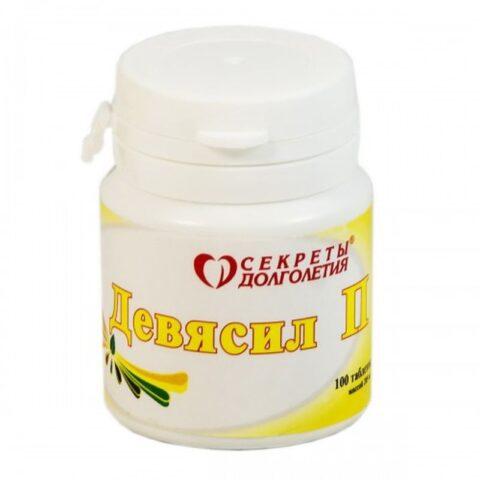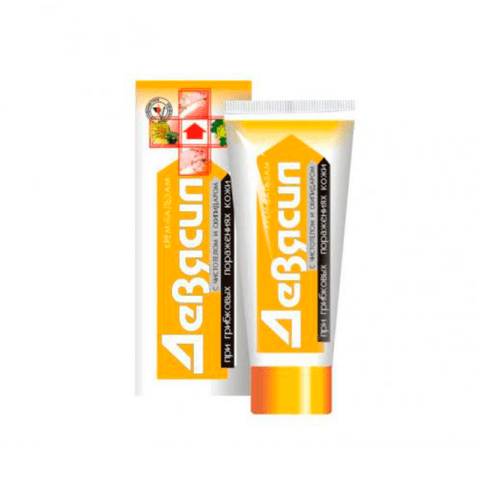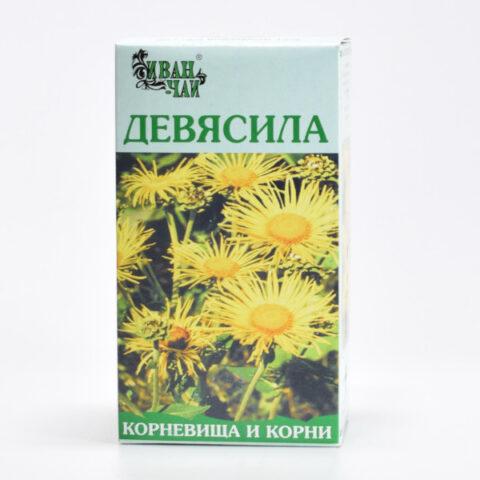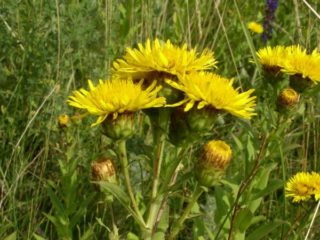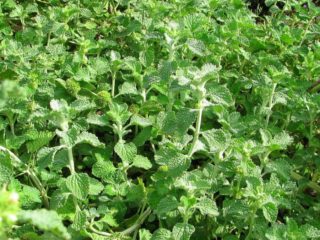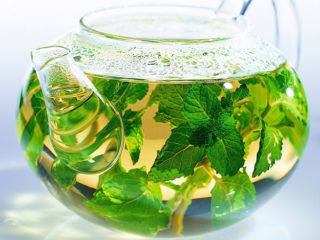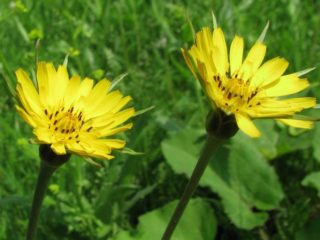Content
- 1 Botanical description
- 2 The value and chemical composition of elecampane
- 3 Why elecampane is useful
- 4 What does elecampane help from, what diseases
- 5 Healing recipes
- 6 The use of elecampane in traditional medicine
- 6.1 For colds
- 6.2 From cough
- 6.3 To strengthen the immune system
- 6.4 With menopause
- 6.5 With arthrosis
- 6.6 From parasites
- 6.7 With pancreatitis
- 6.8 With diabetes mellitus
- 6.9 With diseases of the gastrointestinal tract
- 6.10 With gastritis
- 6.11 With protrusions
- 6.12 From prostatitis
- 6.13 With hemorrhoids
- 6.14 For the liver
- 6.15 With oncology
- 6.16 For skin diseases
- 6.17 With asthma
- 7 Application of elecampane
- 8 Contraindications and side effects when taking elecampane
- 9 Terms and rules for harvesting elecampane roots
- 10 Conclusion
The medicinal properties and use of elecampane are very popular in traditional medicine. Useful rhizomes of the plant relieve negative symptoms in acute and chronic diseases.
Botanical description
Elecampane is a plant from the Astrov family. It has a long-term, sometimes one-year life cycle, is represented by several species that are very similar in appearance to each other.
What does an elecampane plant look like?
A perennial is able to rise up to 3 m above the ground. Shoots are straight, smooth or slightly pubescent, hardly branching. The leaves are large, oblong or lanceolate, with a solid or jagged edge. It blooms in the second half of summer with baskets of yellow or orange color.
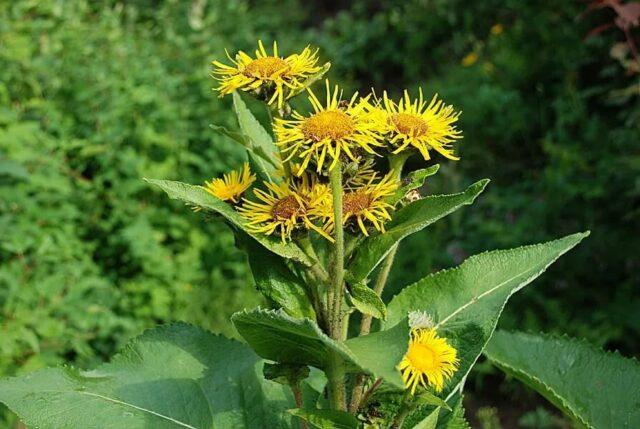
Elecampane inflorescences are single or collected in panicles and shields
Varieties
It is customary to distinguish several types of perennials that are of medical value. Before drug use, you should study the photo, medicinal properties and contraindications of elecampane.
Elecampane high
Tall elecampane (Inula helenium) has the highest medicinal value. It grows about 3 m, the leaves of the plant can stretch up to 50 cm in length, and the flowers reach 8 cm in diameter.
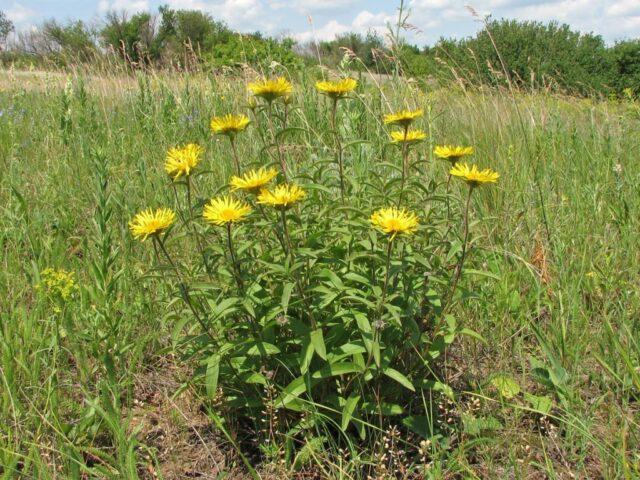
From afar, a tall elecampane can be mistaken for a sunflower
Elecampane magnificent
The magnificent elecampane (Inula magnifica) rises to an average of 2 m in height. It has a thick stem and huge basal leaves, the inflorescences of the species are yellow, up to 15 cm in diameter.

Magnificent elecampane blooms in July and August
Elecampane swordsman
Mechelist elecampane (Inula ensifolia) is a compact plant no more than 30 cm tall. It has strong stems and narrow lanceolate leaves, only about 6 cm long. Blooms in single baskets of yellow color, 2-4 cm each.

Most often, swordsman elecampane grows in the mountains on calcareous and chalk soils.
Elecampane eastern
Eastern elecampane (Inula orientalis) is a plant about 70 cm tall with oblong leaves and dark yellow baskets of inflorescences 10 cm each. In natural conditions, it grows mainly in Asia Minor and the Caucasus.
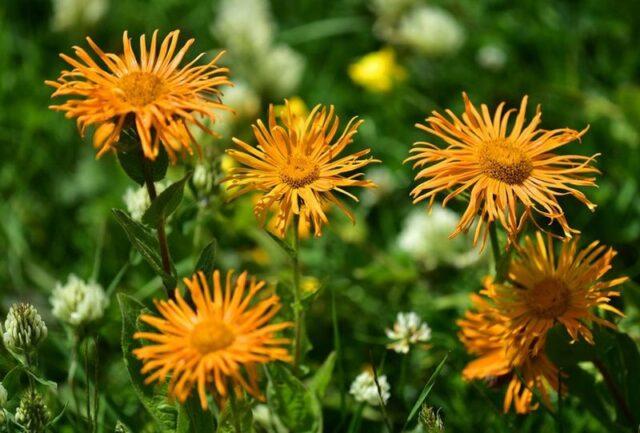
Eastern elecampane has been cultivated since 1804
Where elecampane grows
Elecampane is a widespread plant throughout the world. You can meet him in Europe, North and Central America, Asia, throughout Russia and even in Africa. Perennial prefers light areas with breathable soil.It often settles along the banks of rivers and near lakes, in well-watered meadows, in pine and deciduous forests.
The value and chemical composition of elecampane
Traditional medicine uses mainly elecampane rhizomes and roots for medicinal purposes. They contain many useful substances, namely:
- inulin - up to 40%;
- vitamin C;
- essential oils and resins;
- vitamin E;
- alkaloids;
- tannins;
- sesquiterpenes;
- saponins;
- alant camphor;
- potassium, manganese and iron;
- alactopicrin;
- pectins;
- magnesium and calcium;
- quercetin;
- organic acids;
- alantol and proazulene.
The composition of the plant is represented by proteins and carbohydrates - 2.9 and 0.2 g, respectively. There are only about 15 calories per 100 g of roots.
Why elecampane is useful
A perennial plant has a very beneficial effect on the body. In particular:
- helps fight inflammation and has an antiseptic effect;
- serves as a diuretic and choleretic agent;
- promotes the elimination of toxins and toxins from the body;
- improves digestion and awakens appetite;
- has a calming effect in case of stress and nervous disorders;
- helps with diarrhea;
- improves blood circulation processes;
- promotes healing of wounds and ulcers.
Perennial is used in the fight against intestinal parasites. The plant inhibits their vital activity and helps to quickly remove the worms from the body.
For men
The medicinal properties of elecampane for men are used for diseases of the reproductive system. Healing remedies based on it relieve inflammation and pain, help to cope with hemorrhoids. The plant is used to enhance potency and to improve the quality of semen.
For women
Perennial is actively used in the gynecological field, elecampane root helps with delays in menstruation in women, with inflammatory ailments and pain in the uterus. Vitamin E in the composition of the plant has a positive effect on the condition of hair and skin, slows down the aging process and improves cell metabolism.
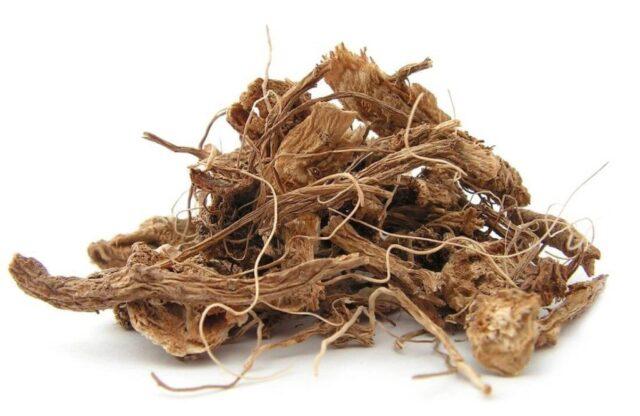
Elecampane root can be used to relieve urinary inflammation
Can i take during pregnancy and with hepatitis B?
The medicinal properties and contraindications of elecampane for women are ambiguous. Despite the benefits, it is not used during pregnancy. Phytohormones in the root of a plant can cause uterine bleeding and lead to miscarriage.
Also, perennial-based products are not recommended for lactation. The active substances of the plant can cause allergies in babies or provoke intestinal colic.
At what age can elecampane be given to children
Perennial is mainly used to treat cough in children, it has anti-inflammatory and expectorant properties. At the same time, it is allowed to offer herbal preparations to a child only upon reaching the age of three. In babies, the plant can cause stomach upset and allergies.
What does elecampane help from, what diseases
The use of elecampane root in folk medicine and traditional therapy is aimed at treating a wide variety of ailments. Among them:
- kidney stone disease;
- cough and bronchitis;
- helminthic invasions;
- diabetes;
- hemorrhoids;
- rheumatism and arthritis;
- hypertension and epilepsy;
- vascular spasms;
- headaches;
- gastritis and stomach ulcers;
- liver disease.
The plant has a good effect on sluggish appetite, with a slowed flow of bile. It can be used for a speedy recovery from colds and SARS.
Does elecampane help with weight loss
Perennial root is used in diets to reduce appetite. The remedy is usually taken like this, pour a glass of cold water 15 g of crushed raw materials and consume the infusion three times a day. The plant makes it easier to tolerate food restrictions, and also stimulates the removal of toxins and toxins from the body.
Healing recipes
Traditional medicine suggests using a perennial plant in several dosage forms. With any method of preparation, elecampane retains a maximum of valuable properties.
Decoction
To prepare a medicinal decoction, you must:
- grind the dry root in the volume of a large spoon;
- pour raw materials with a glass of boiling water;
- in a water bath, bring to a boil;
- boil for seven minutes;
- insist under the lid for two hours.
The remedy is used for bronchitis and cough, it removes phlegm and fights bacteria.
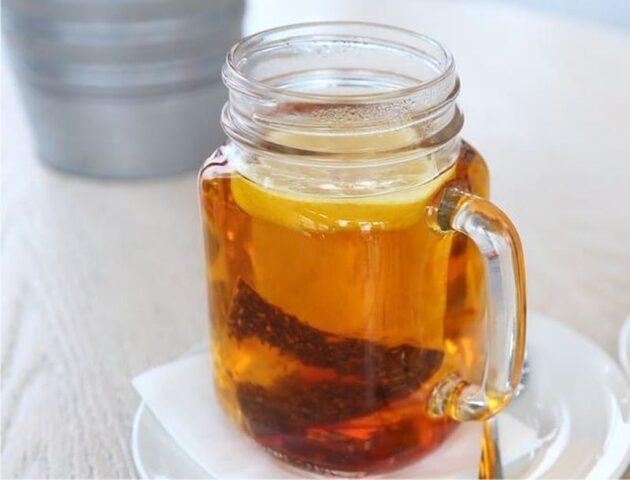
You can use a decoction of elecampane to rinse your hair and wipe your skin
Infusion
Instructions for the use of rhizomes and roots of elecampane suggests preparing an aqueous infusion of them. They do it like this:
- a small spoonful of crushed raw materials is poured with a glass of cool water;
- leave for eight hours;
- filter through cheesecloth.
Drinking a remedy from elecampane is necessary for diseases of the gastrointestinal tract according to recipes.
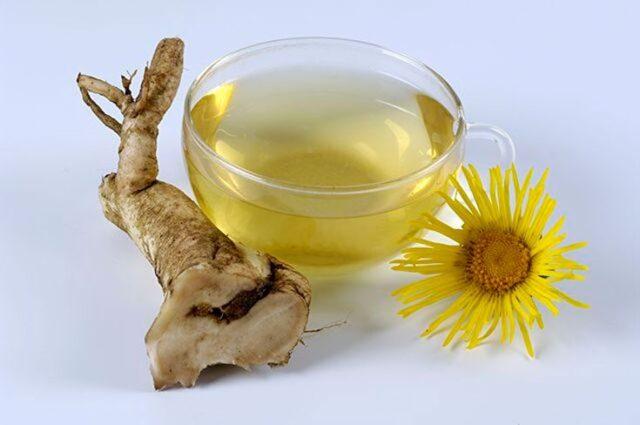
Infusion of elecampane strengthens the immune system during the autumn viruses
Tincture
Alcohol tincture is often used in the treatment of gastrointestinal ailments and inflammations. They do it like this:
- a large spoonful of dry raw materials is poured with 500 ml of vodka;
- seal the container and shake;
- put away in a dark place for two weeks.
The finished product needs to be filtered. The drug is taken according to specific prescriptions.
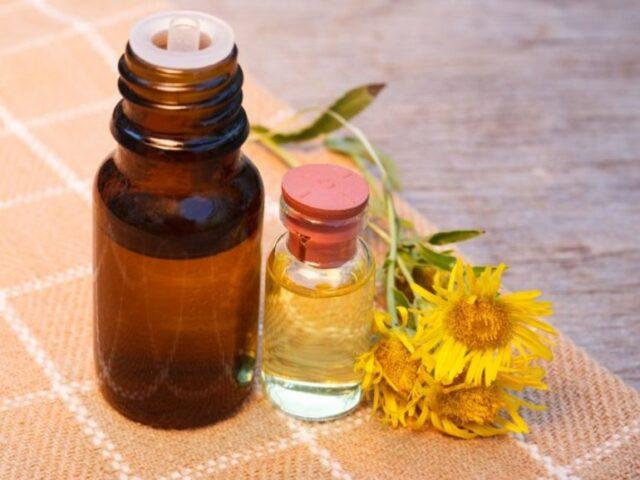
A single dosage of elecampane tincture usually does not exceed 30 drops
Tea
Perennial root tea is good for rheumatism, headache, toothache, flu and colds. The recipe for the preparation looks like this:
- a small spoonful of roots is poured with a glass of hot water;
- stand under the lid for 15 minutes;
- passed through cheesecloth or fine sieve.
You can drink a drink from elecampane a cup a day, if desired, honey can be added to the product.
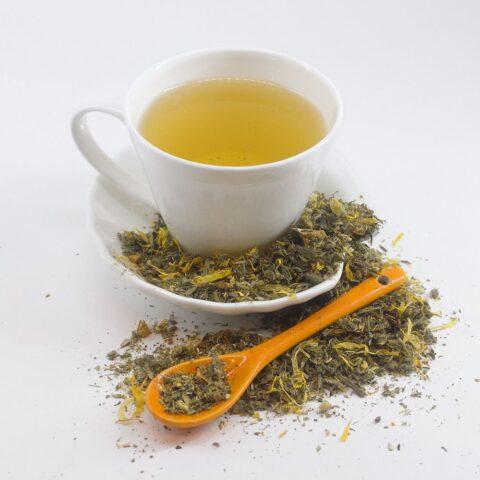
Elecampane tea, like a regular drink, is best consumed on a full stomach.
Ointment
Perennial rhizomes can be used externally for joint and skin diseases. Homemade ointment is prepared according to this recipe:
- a small amount of roots is ground into powder;
- mixed with slightly melted butter or lard in a 1: 5 ratio;
- mix thoroughly and put into the refrigerator for solidification for several hours.
The finished ointment from elecampane is applied in a thin layer to the affected areas. You do not need to rub in the product, just cover it with a bandage or folded gauze on top.
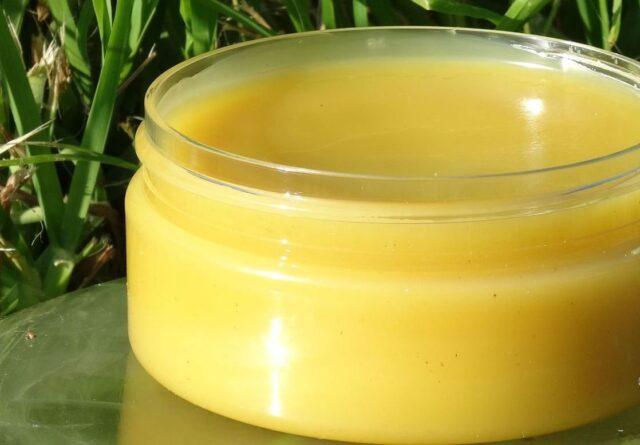
The consistency of the elecampane ointment should turn out to be dense and viscous
Root Powder
Perennial powder is used for cholecystitis, hepatitis, peptic ulcer and hypertension. The preparation is very simple:
- the root is thoroughly dried;
- crushed in a blender or coffee grinder to fine dust.
You can use the product dry with a pinch of water twice a day on an empty stomach. It is also allowed to immediately dissolve the raw materials in liquid.
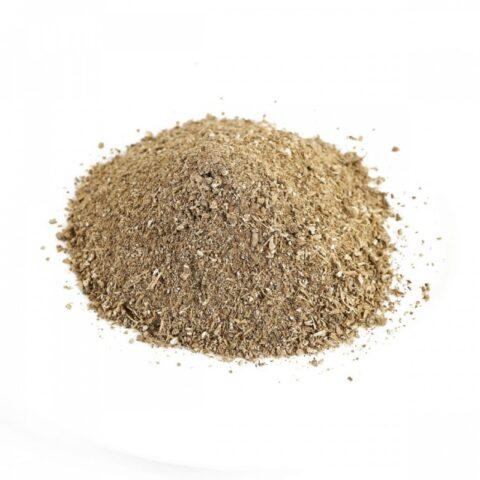
On the basis of rhizome powder, it is especially convenient to prepare infusions and decoctions
The use of elecampane in traditional medicine
Elecampane has great medicinal value. Traditional medicine advises using it for a wide variety of ailments - inflammatory, metabolic, digestive.
For colds
For the treatment of flu and colds, a medicinal decoction is used. Prepare it like this:
- the crushed roots of elecampane and angelica are mixed in equal amounts over a large spoon;
- pour 1 liter of hot water;
- boil on the stove for ten minutes.
The finished drink is filtered and consumed in 100 ml three times a day in a warm form.
From cough
When coughing and bronchitis, use the following decoction based on a medicinal plant:
- a large spoonful of chopped elecampane root is poured with a glass of boiling water;
- keep in a water bath for 30 minutes;
- the broth is cooled and filtered;
- topped up with clean water to the initial volume.
Throughout the day, the product should be taken in small portions until the entire glass is drunk.
To strengthen the immune system
In the autumn, to protect against flu and colds, you can use the following decoction:
- a small spoonful of dry roots is crushed;
- pour a glass of hot water;
- boil for ten minutes over low heat;
- cool and pass the product through cheesecloth.
You need to take the broth up to six times a day for a large spoon. The drink not only improves immunity, but also has a good effect on sore throat.
With menopause
The beneficial properties of elecampane root are used in the initial stage of menopause, if a woman wants to restore the monthly cycle. The recipe for the drug looks like this:
- a small spoonful of dry roots is ground into powder;
- pour 200 ml of boiling water;
- boil over low heat for 15 minutes and remove from the stove.
The broth must be insisted under the lid for several hours, then filtered and taken three small spoons per day for no more than four days in a row. The cycle should recover on the second day. If this did not happen for the entire course, the drug should be stopped.
With arthrosis
With joint ailments, inflammation and pain relieves tincture of elecampane. Prepare it as follows:
- 100 g of dry roots are poured with 250 ml of alcohol;
- close the container with a lid and put it in a dark place for two weeks;
- the finished product is filtered.
The tincture is used to rub joints on a daily basis in the evenings. After applying the drug, the sore spot should be wrapped warmly.
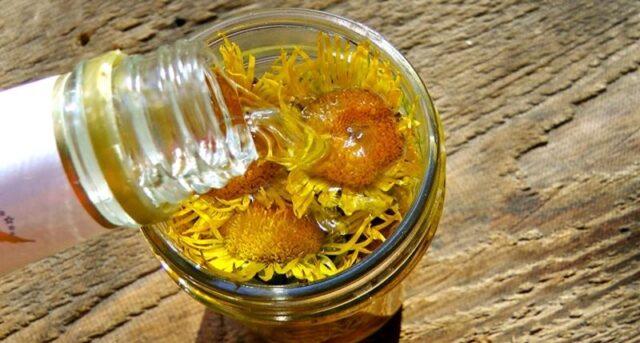
Elecampane tincture has strong warming properties
From parasites
A drink made from elecampane and some other medicinal herbs has a good effect on parasites in the intestines. To get rid of helminths and roundworms, you must:
- take 30 g of elecampane, thyme, tansy and St. John's wort;
- add a similar amount of burdock, centaury and eucalyptus;
- chop all herbs;
- measure 75 g of the mixture and pour 300 ml of water;
- boil for seven minutes and leave for another hour.
A little honey is added to the product and four large spoons are taken three times a day on a full stomach. You need to continue treatment for two weeks, then take a break for another seven days and repeat the course twice.
With pancreatitis
Elecampane works well on the pancreas during the remission of pancreatitis. This broth is prepared:
- a large spoonful of elecampane is mixed with the same amount of mother-and-stepmother;
- add two large spoons of the string;
- Pour herbs with 500 ml of water and boil for five minutes.
Under the lid, the product should be kept for about two hours. During the day, the broth is completely finished to the end, taking it in small portions at short intervals.
With diabetes mellitus
Perennial regulates blood glucose levels and prevents diabetes complications. The remedy is prepared as follows:
- two small spoons of dry raw materials are soaked in 500 ml of cold water;
- insist in the heat for eight hours;
- pass the product through cheesecloth.
You need to take the infusion half a glass four times a day on an empty stomach.
With diseases of the gastrointestinal tract
For abdominal pain, frequent constipation and other digestive disorders, the following infusion helps:
- a small spoonful of crushed rhizomes are poured with a glass of boiling water;
- ten hours insist under the lid;
- passed through folded gauze.
You need to take the remedy for 1/4 cup on an empty stomach three times a day.
With gastritis
The benefits and harms of elecampane for gastritis depend on the level of acidity. They use a medicinal plant with an increased production of gastric juice, since it reduces the amount of secreted enzymes. The medicine is done like this:
- a small spoonful of raw materials is poured with a glass of chilled water;
- leave to infuse for eight hours;
- filtered.
Take an infusion of 50 ml four times a day.
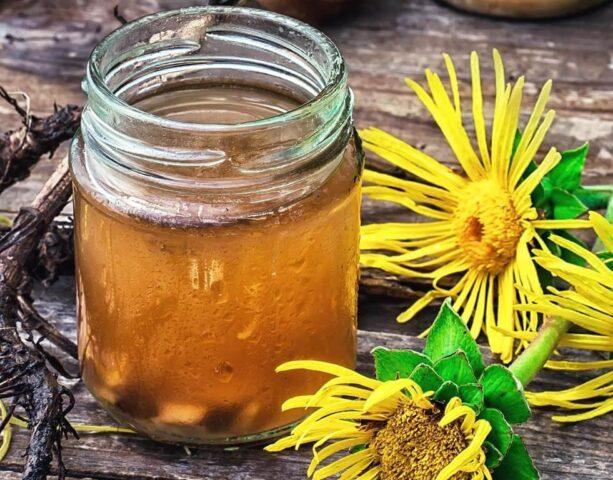
With gastritis, elecampane broth is drunk shortly before meals, but not in a state of severe hunger
With protrusions
A perennial is not capable of eliminating protrusion of the spine, but it helps well with pain. Homemade ointment is usually used:
- a large spoonful of grated roots are mixed with five large tablespoons of bacon;
- melt the mixture in a water bath for ten minutes;
- Strain hot through folded gauze.
The cooled homogeneous product is applied to problem areas and wrapped in a warm cloth for an hour. You can apply the ointment daily, but it is really possible to completely eliminate protrusion only by surgery.
From prostatitis
To relieve inflammation and pain with prostatitis, use the following decoction of elecampane:
- 30 g of dry root is crushed;
- pour 500 ml of hot water;
- boil for half an hour.
The cooled agent is filtered and sipped every two hours during the day.
With hemorrhoids
Medicines based on elecampane promote resorption of hemorrhoids. A good effect is brought by such an infusion:
- a small spoonful of dry root is ground into powder;
- pour 250 ml of warm water;
- kept under the lid for about five hours.
The filtered agent is taken on an empty stomach four times a day, a single serving is 50 ml.
For the liver
In case of liver ailments, the collection of medicinal herbs has a beneficial effect. For cooking you need:
- mix 15 g of elecampane and artichoke extract;
- add 45 g each of dandelion and immortelle;
- add 30 g of corn stigmas and 55 g of burdock;
- grind the entire collection to a powder and measure out two small spoons.
The components are poured with a glass of boiling water, insisted for two hours and taken twice a day, 200 ml.
With oncology
Elecampane for oncology can be used in combination with official medicines. Such infusion brings benefits:
- the roots of the plant are ground into powder in the volume of a glass;
- combined with 500 ml of fresh honey;
- stir thoroughly and cover with a lid;
- insist during the day.
You need to take the mixture in a large spoonful three times a day on an empty stomach.
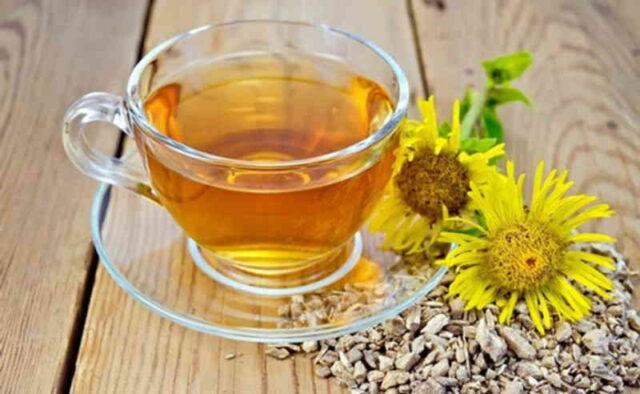
Elecampane in cancer therapy mitigates the unpleasant effects of chemotherapy
For skin diseases
For dermatitis and eczema, a decoction of elecampane can be used for washing. The tool is done like this:
- 100 g of dry raw materials are poured into 1 liter of hot water;
- insist for four hours;
- filtered through cheesecloth.
You can wipe the sore skin with a drug several times a day until the condition improves.
With asthma
The following remedy helps to reduce the frequency of asthmatic attacks:
- a large spoonful of crushed root is poured with a glass of water;
- boil for 15 minutes;
- passed through cheesecloth.
You need to take the remedy twice a day, if desired, the drink is flavored with a spoon of honey.
Application of elecampane
Traditional medicine is not the only area where the medicinal properties and contraindications of the high elecampane root are appreciated. The plant can be found in traditional medicines, and is also used for skin and hair care.
In official medicine
Elecampane extract is present in several pharmaceutical preparations:
- tablets Elecampane-P;
Elecampane-P is taken for coughs, gastrointestinal ailments and skin diseases
- cream elecampane - the agent is used in the treatment of wounds and burns;
Cream with elecampane extract accelerates regeneration processes
- herbal tea Roots elecampane - the collection is used to increase immune resistance.
You can take pharmacy tea from elecampane roots when you cough
In pharmacies, perennial essential oil is also available for purchase. It is used not only for aromatizing rooms, but also for external use on the skin to heal wounds and ulcers.
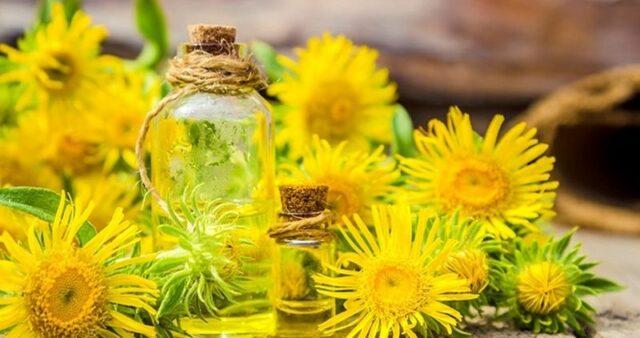
Elecampane oil has a strong antiseptic effect
In cosmetology
The root contains vitamins E and C. Infusions and decoctions based on perennials are well suited for washing in the morning and evening.The face from such care becomes fresher, fine wrinkles disappear, and the elasticity of the skin improves.
Powder from the roots is used in homemade cosmetic masks. You can mix it with honey - the product will cleanse your face from acne and blackheads. Alcohol tincture is also beneficial for rashes, it is applied pointwise to acne for moxibustion.
Hair can be rinsed after washing with elecampane broth. The tool will not only strengthen the subcutaneous follicles, but also help to cope with dandruff, and also return a healthy shine to the curls.
Contraindications and side effects when taking elecampane
When using the medicinal properties of elecampane at home, contraindications must be taken into account. It is prohibited to use drugs based on perennials:
- with serious cardiovascular ailments;
- during pregnancy and breastfeeding;
- with gastritis with low acidity;
- with hypotension;
- with a tendency to bleeding;
- with individual allergies.
It is necessary to take decoctions, infusions and other means in strict accordance with the recipes. If you experience nausea, diarrhea, headache or rash, you should immediately stop using the medication and consult a doctor.
Terms and rules for harvesting elecampane roots
The roots of elecampane are harvested in spring when the first leaves appear or in autumn, after leaf fall, but before frost. Plants older than two years are dug up entirely, the upper part is cut off, and the underground processes are shaken off the ground and washed with water. The side roots are usually removed, leaving only the main shaft.
Before drying, the raw materials are cut into pieces of 10 cm and left in the fresh air for three days. Then they are placed in an oven heated to 40 ° C and left with the door open until the roots begin to break easily.
It is necessary to store medicinal raw materials in wooden containers, paper bags or fabric bags. Elecampane retains valuable properties for three years.
Conclusion
The medicinal properties and use of elecampane are of great importance in traditional medicine. The plant helps to cope with inflammation and improves the condition of severe chronic ailments.
